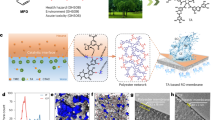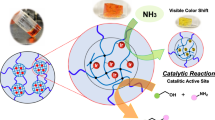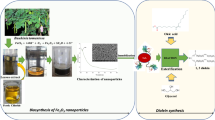Abstract
The present article reports a new method for the synthesis of ‘artificial urushi’ using cardanol, a major ingredient of cashew nutshell liquid, as the starting monomer. Natural urushi sap is polymerized in a water-in-urushiol (w/o) emulsion system; here, we mimic this system for the polymerization of cardanol. The combination of a weak amine base and a weak carboxylic acid functions as efficient emulsifier. The polymerization of cardanol is carried out in a water-in-cardanol (w/o) emulsion to produce a prepolymer emulsion, which is further cured by crosslinking, resulting in the biomimetic polymerization of cardanol. The prepolymer emulsion is stable for storage. The films were prepared from the prepolymer emulsion; the curing of these films was achieved by thermal annealing or by cobalt naphthenate-catalyzed crosslinking in air to generate ‘artificial urushi’. The rheological properties of the cardanol monomer and the prepolymer emulsions resulted in excellent film formation on the substrate. Physical property examinations of the cured films showed sufficient hardness for use as a coating layer. Cardanol is a renewable resource, and no organic solvent was used, and thus, this polymerization is a green chemical process.
Similar content being viewed by others
Log in or create a free account to read this content
Gain free access to this article, as well as selected content from this journal and more on nature.com
or
References
Kobayashi, S., Uyama, H. & Ikeda, R. Artificial urushi. Chem. Eur. J. 7, 4755–4760 (2001).
Ikeda, R., Tsujimoto, T., Tanaka, H., Oyabu, H., Uyama, H. & Kobayashi, S. Man-made urushi-preparation of crosslinked polymeric films from renewable resources via air-oxidation processes. Proc. Jpn Acad., Ser. B 76, 155–160 (2000).
Kobayashi, S. Artificial urushi. J. Adhesion Soc. Jpn 49, 468–473 (2013).
Rogue, B. V. A. History of Japanese Lacquer Work, (University of Toronto Press, Toronto, Ontario, 1976).
Vogl, O. Oriental lacquer, poison ivy, and drying oils. J. Polym. Sci. Part A Polym. Chem. 38, 4327–4335 (2000).
Kumanodani, J. in Polymeric Materials Encyclopedia (ed. Salamone J. C.) 4835–4842 (CRC Press, Inc., Boca Raton, FL, 1996).
Yoshida, H. Chemistry of lacquer (Urushi). Part I. Communication from the Chemical Society of Tokio. J. Chem. Soc., Trans. 43, 472–486 (1883).
Bertrand, G. Sur le latex de l'abre laque. Compt. Rend. 118, 1213–1218 (1894).
Majima, R. Über den Hauptbestandteil des Japanlacks. (I. Mitteilung.) Über urushiol und urushioldimethyläthe. Ber. Dtsch. Chem. Ges. B 42, 1418–1423 (1909).
Majima, R. Über den Hauptbestandteil des Japan-Lacks, IX. Mitteilung: chemische Untersuchung der verschiedenen natürlichen Lackarten, die dem Japan-Lack nahe verwandt sind. Ber. Dtsch. Chem. Ges. B 55, 191–214 (1922).
Symes, W. F. & Dawson, C. R. Poison ivy “urushiol”. J. Am. Chem. Soc. 76, 2959–2963 (1954).
Loev, B. & Dawson, C. R. On the geometrical configuration of the olefinic components of poison ivy urushiol. The synthesis of a model compound. J. Am. Chem. Soc. 78, 1180–1183 (1956).
Tsujimoto, T., Ikeda, R., Uyama, H. & Kobayashi, S. Synthesis and curing of crosslinkable polyphenols from urushiol analogues. Chem. Lett. 29, 1122–1123 (2000).
Tsujimoto, T., Ikeda, R., Uyama, H. & Kobayashi, S. Crosslinkable polyphenols from urushiol analogues. Macromol. Chem. Phys. 202, 3420–3425 (2001).
Kobayashi, S., Ikeda, R., Oyabu, H., Tanaka, H. & Uyama, H. Artificial urushi: design, synthesis, and enzymatic curing of new urushiol analogues. Chem. Lett. 29, 1214–1215 (2000).
Ikeda, R., Oyabu, H., Tanaka, H., Uyama, H. & Kobayashi, S. Preparation of artificial urushi via an environmentally benign process. Bull. Chem. Soc. Jpn. 74, 1067–1073 (2001).
Tsujimoto, T., Uyama, H. & Kobayashi, S. Synthesis and curing behaviors of cross-linkable polynaphthols from renewable resources: preparation of artificial urushi. Macromolecules 37, 1777–1782 (2004).
Ikeda, R., Tanaka, H., Uyama, H. & Kobayashi, S. A new crosslinkable polyphenol from a renewable resource. Macromol. Rapid Commun. 21, 496–499 (2000).
Ikeda, R., Tanaka, H., Uyama, H. & Kobayashi, S. Enzymatic synthesis and curing of poly(cardanol). Polym. J. 32, 589–593 (2000).
Ikeda, R., Tanaka, H., Uyama, H. & Kobayashi, S. Synthesis and curing behaviors of a crosslinkable polymer from cashew nut shell liquid. Polymer 43, 3475–3481 (2002).
Higashimura, H., Kubota, H., Shiga, A., Fujisawa, K., Moro-oka, Y., Uyama, H. & Kobayashi, S. “Radical-controlled” oxidative polymerization of 4-phenoxyphenol by a tyrosinase model complex catalyst to poly(1,4-phenylene oxide). Macromolecules 33, 1986–1995 (2000).
Kobayashi, S. & Higashimura, H. Oxidative polymerization of phenols revisited. Prog. Polym. Sci. 28, 1015–1048 (2003).
Kobayashi, S. Chemistry Today 28–35 (Tokyo Kagaku Dojin, Tokyo, 2003).
Kim, Y. H., An, E. S., Song, B. K. & Kim, D. S. Polymerization of cardanol using soybean peroxidase and its potential application as anti-biofilm material. Biotechnol. Lett. 25, 1521–1524 (2003).
Won, K., Kim, Y. H., An, E. S., Lee, Y. S. & Song, B. K. Horseradish peroxidase-catalyzed polymerization of cardanol in the presence of redoxm mediators. Biomacromolecules 5, 1–4 (2004).
Tsujimoto, T., Ando, N., Oyabu, H., Uyama, H. & Kobayashi, S. Laccase-catalyzed curing of natural phenolic lipids and product properties. J. Macromol. Sci. Pure Appl. Chem A44, 1055–1060 (2007).
Park, S. Y., Kim, Y. H., Won, K. & Song, B. K. Enzymatic synthesis and curing of polycardol from renewable resources. J. Mol. Catal. B Enzym. 57, 312–316 (2009).
Chelikani, R., Kim, Y., Yoon, D.-Y. & Kim, D.-S. Enzymatic polymerization of natural anacardic acid and antibiofouling effects of polyanacardic acid coatings. Appl. Biochem. Biotechnol. 157, 263–277 (2009).
Souza, F. G., Richa, P., de Siervo, A., Oliveira, G. E., Rodrigues, D. H. M., Nele, M. & Pinto, J. C. New in situ blends of polyaniline and cardanol bio-resins. Macromol. Mater. Eng. 293, 675–683 (2008).
Shibata, M., Itakura, Y. & Watanabe, H. Bio-based thermosetting resins composed of cardanol novolac and bismaleimide. Polym. J. 45, 758–765 (2013).
Zhou, Q., Cho, D. W., Song, B. K. & Kim, H. J. Curing behavior of polycardanol by MEKP and cobalt naphthenate using differential scanning calorimetry. J. Therm. Anal. Calorim. 99, 277–284 (2010).
Voirin, C., Caillol, S., Sadavarte, N. V., Tawade, B. V., Boutevin, B. & Wadgaonkar, P. P. Functionalization of cardanol: towards biobased polymers and additives. Polym. Chem. 5, 3142–3162 (2014).
Watanabe, H., Fujimoto, A. & Takahara, A. Characterization of catechol-containing natural thermosetting polymer “urushiol” thin film. J. Polym. Sci. Part A Polym. Chem. 51, 3688–3692 (2013).
Watanabe, H., Fujimoto, A. & Takahara, A. Surface texturing of natural ‘urushi’ thermosetting polymer thin films. Polym. J. 46, 216–219 (2014).
Yamaguchi, S., Tanha, M., Hult, A., Okuda, T., Ohara, H. & Kobayashi, S. Green polymer chemistry: lipase-catalyzed synthesis of bio-based reactive polyesters employing itaconic anhydride as a renewable monomer. Polym. J. 46, 2–13 (2014).
Yoshimura, Y., Nojiri, M., Arimoto, M., Ishimoto, K., Aso, Y., Ohara, H., Yamane, H. & Kobayashi, S. Green polymer chemistry: one-pot, metal-free synthesis of macromonomer via direct polycondensation of lactic acid and its radical polymerization to graft and comb polymers. Polymer 90, 342–350 (2016).
Kobayashi, S., Uyama, H. & Kimura, S. Enzymatic polymerization. Chem. Rev. 101, 3793–3818 (2001).
Kobayashi, S. & Makino, A. Enzymatic polymer synthesis: an opportunity for green polymer chemistry. Chem. Rev. 109, 5288–5353 (2009).
Kobayashi, S. Green polymer chemistry: recent developments. Adv. Polym. Sci. 262, 141–166 (2013).
Shoda, S., Uyama, H., Kadokawa, J., Kimura, S. & Kobayashi, S. Enzymes as green catalyst for precision macromolecular synthesis. Chem. Rev. 116, 2307–2413 (2016).
Amari, T., Kumanotani, J. & Achiwa, M. Viscoelastic properties of a sap of Japanese lac trees and the lac from it. J. Jpn. Soc. Color Mater. 53, 629–634 (1980).
Matsui, E. Urushi kagaku (Urushi chemistry), (Nikkan Kogyo Sinbun Co., Tokyo, 1997).
Miyakoshi, T., Nagase, K. & Yoshida, T. Urushi kagaku no simpo (Developments of urushi chemistry), (IPC Co., Tokyo, 2000).
Obataya, E., Furuta, Y., Ohno, Y., Norimoto, M. & Tomita, B. Effect of aging and moisture on the dynamic viscoelastic properties of oriental lacquer (urushi) film. J. Appl. Polym. Sci. 83, 2288–2294 (2002).
Author information
Authors and Affiliations
Corresponding authors
Ethics declarations
Competing interests
The authors declare no conflict of interest.
Rights and permissions
About this article
Cite this article
Otsuka, T., Fujikawa, Si., Yamane, H. et al. Green polymer chemistry: the biomimetic oxidative polymerization of cardanol for a synthetic approach to ‘artificial urushi’. Polym J 49, 335–343 (2017). https://doi.org/10.1038/pj.2016.118
Received:
Revised:
Accepted:
Published:
Issue date:
DOI: https://doi.org/10.1038/pj.2016.118
This article is cited by
-
Salt Spray Resistant Acrylic Copolymers Containing Bio-based Cardanol Molecules with Hybrid Thermoplastic-Thermoset Characteristics
Journal of Polymers and the Environment (2024)
-
Nature-inspired materials: Emerging trends and prospects
NPG Asia Materials (2021)
-
Preparation of biobased wrinkled surfaces via lignification-mimetic reactions and drying: a new approach for developing surface wrinkling
Polymer Journal (2017)
-
Green polymer chemistry: new methods of polymer synthesis using renewable starting materials
Structural Chemistry (2017)



